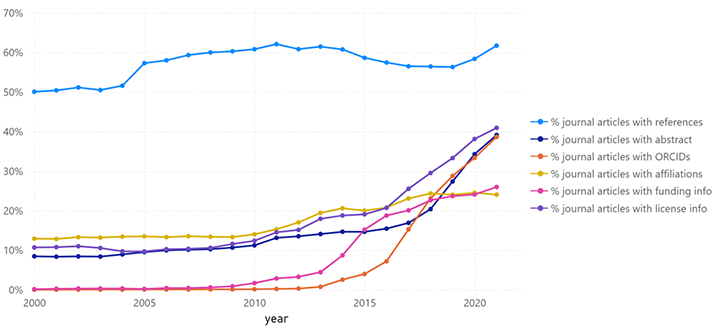Q&A about Wiley's decision to open its abstracts
In this post Ludo Waltman and Bianca Kramer reflect on today’s announcement that Wiley is joining the Initiative for Open Abstracts (I4OA) and is going to make abstracts openly available through Crossref.
Why is it important that abstracts are made openly available?
In a blog post that we published two years ago together with our colleague Aaron Tay, we discussed numerous ways in which open abstracts can be of great value. This includes scientific literature search, both using traditional query-based search tools and using more advanced text mining and visualization tools. It also includes the analysis of the structure and dynamics of research fields using bibliometric visualization tools such as VOSviewer and CiteSpace. In addition, we pointed out that open abstracts can be used to support systematic literature reviewing, to algorithmically identify relations between scholarly outputs, to assign these outputs to research topics or research fields, and to enable automatic knowledge extraction, for instance by algorithmically identifying biomedical entities and gene-disease associations.
Publishers typically make abstracts freely available on their websites. However, to support the above use cases, it is essential that abstracts are openly available in a centralized infrastructure. For publishers that work with Crossref to register DOIs for their content, the Initiative for Open Abstracts (I4OA) recommends making abstracts openly available through Crossref.
Many other publishers have already opened their abstracts. What is the significance of the step taken by Wiley?
Indeed many publishers have already opened their abstracts, and of these publishers 100 are also formal supporters of I4OA. This includes Hindawi, Royal Society, and SAGE, three of the founding organizations of I4OA. Abstracts are currently openly available for 39% of the journal articles in Crossref in the period 2020-2022. Until today, however, of the world’s five largest publishers, in terms of number of journal articles, MDPI was the only one supporting I4OA. Of these five publishers, Wiley is now the second one joining I4OA. It follows the example of Hindawi, which was acquired by Wiley last year. Given that Wiley published 6% of the journal articles in Crossref in the period 2020-2022, we see Wiley’s support for I4OA as an important milestone for openness of abstracts.
What do you expect other large publishers will do?
With support for I4OA from the world’s third (Wiley) and fourth (MDPI) largest publisher, we do not see any credible argument for other large publishers, in particular Elsevier, Springer Nature, and Taylor & Francis, to withhold their support for open abstracts.
Springer Nature is under pressure from the editors of its flagship journal Nature to support open abstracts. It is already making abstracts openly available through Crossref for its open access content, but unlike Wiley and other publishers supporting I4OA, its policy is not to make abstracts openly available for its subscription content. Extending its support for open abstracts to all its content seems a natural next step for Springer Nature.
While it may take a bit more time, we expect that Taylor & Francis and Elsevier will follow as well. Taylor & Francis has a daughter company, F1000, that was one of the initial supporters of I4OA. We do not see any reason for Taylor & Francis not to follow the example of its daughter company.
In an apparent attempt to protect its Scopus business, Elsevier initially declined to open its citations, despite strong protest from the scientometric community. However, in 2020, Elsevier changed its position and joined the Initiative for Open Citations (I4OC). Of the larger publishers, Elsevier was one of the last ones to open its citations. To prevent this history from repeating itself, we are hopeful that Elsevier will act more swiftly in opening its abstracts.
How does the step taken by Wiley fit into the bigger picture of openness of metadata of scholarly outputs?
While openness of abstracts and citations is of critical importance, it is of limited value if other metadata is not made openly available as well. This for instance includes affiliation and funding metadata, license information, and links between scholarly outputs, such as links between preprints and the corresponding journal articles or between journal articles and the associated data sets. This metadata should as much as possible make use of openly-governed persistent identifiers, for instance ORCID and ROR identifiers.
As can be seen in the figure below, in recent years publishers have made significant progress in making metadata of journal articles openly available through Crossref. More detailed statistics reported in this preprint show that Wiley is doing a good job by making affiliation metadata openly available. Other large publishers, such as Elsevier, Springer Nature, and MDPI, have not yet taken this step. Like many publishers, Wiley is also making funding metadata openly available. However, as shown in recent analyses (see here and here), for many publishers the funding metadata made available through Crossref suffers from gaps and other quality issues.

Percentage of journal articles with open metadata in Crossref. Source: Van Eck & Waltman (2022, Figure 2).
In some cases, metadata that is not made available through Crossref can be obtained from other open data sources, such as OpenAlex. OpenAlex collects affiliation metadata from publisher websites and makes this metadata openly available. As shown in a recent analysis performed by one of us, OpenAlex is able to provide affiliation metadata for publishers that do not deposit this metadata to Crossref. However, this metadata has not been ‘authorized’ by publishers and may suffer from inaccuracies due to technical challenges in the algorithmic extraction of metadata from publisher websites.
Similarly, OpenAlex is able to provide abstracts for 75-80% of the recent journal articles in Crossref, partly by scraping abstracts from publisher websites, which might cause accuracy issues. These abstracts are made available in an ‘inverted format’ (i.e., as a list of individual words with location indicators) for copyright reasons, which is somewhat cumbersome and potentially less sustainable than having abstracts made available by publishers in their Crossref metadata.
How can researchers and other actors in the research community contribute to openness of abstracts and other metadata?
Realizing openness of abstracts and other metadata requires significant efforts by publishers and their technology providers, and also by the team of Crossref. Other actors in the research community can contribute as well, in particular by showing the value they attach to open metadata.
Researchers can contribute by taking openness of metadata, including abstracts, into account when choosing the journal to which they submit their work. Openness of metadata will reduce the dependency on proprietary platforms such as Scopus and Web of Science for discovery of research and assessment of researchers. Crossref provides Participation Reports that researchers can use to get a quick overview of the metadata that a publisher makes openly available through Crossref.
Research funders can make a contribution by including openness of metadata as a requirement in their open access policies. This is for instance already done in Plan S. Likewise, research institutions and their libraries can contribute by including openness of metadata in their negotiations with publishers, as suggested by the TIB library, one of the more than 60 stakeholders supporting I4OA.
If you would like to contribute to openness of abstracts, the I4OA team is happy to help. Feel free to reach out, either on Twitter or by email.




0 Comments
Add a comment